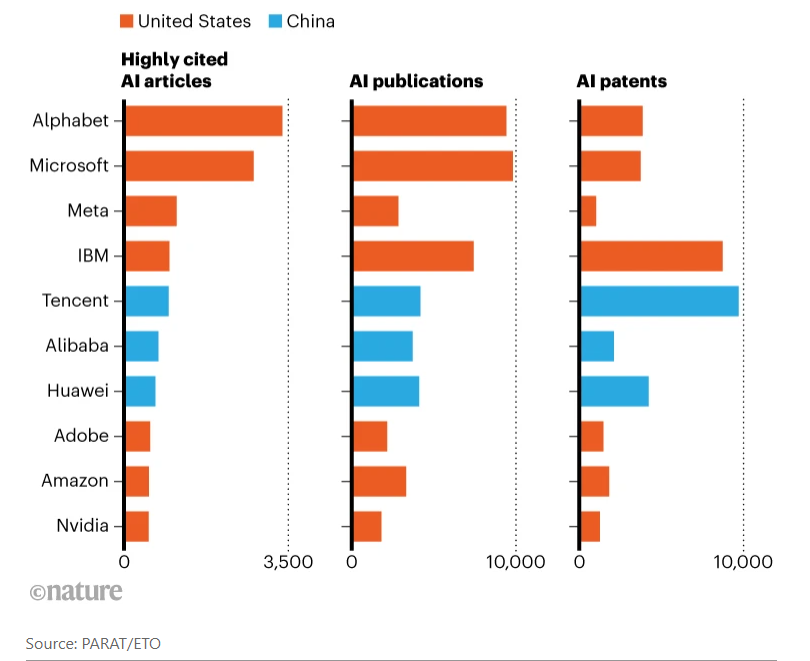Competition in the field of artificial intelligence is becoming increasingly fierce, and technology giants are vying for it. Who can win in the end? Recently, Nature magazine highlighted a report from the PARAT database, which was released by the Center for Security and Emerging Technologies (CSET) at Georgetown University. It comprehensively revealed the competition in the global AI industry by analyzing research papers, patent applications and talent data. pattern. The report not only subverts some of our inherent perceptions of the AI industry, but also provides a valuable reference for us to predict future development trends.
In the fierce competition for artificial intelligence, who is the real leader? Recently, a latest report from the PARAT database unveiled the mystery of the global AI industry and presented an amazing competitive landscape. This data, highlighted by Nature magazine, not only subverts our inherent knowledge, but also shows us the latest development trends in the field of AI.
In a corner of this arena, two technology giants, Alphabet (the parent company of Google) and Microsoft in the United States, stand out from the crowd with their absolute advantage in the number of citations of AI papers. At the other end of the arena, China's Baidu and Tencent have shown strong stamina with their staggering number of patent applications.

The referee in this competition is the Emerging Technology Observatory (ETO) PARAT database. Part of the Center for Security and Emerging Technologies (CSET), the think tank based at Georgetown University’s School of Foreign Service provides a fresh perspective on AI activity by tracking private sector AI activity, including research papers, patent publications, and talent metrics. The development trend of AI.
Ngor Luong, senior analyst at CSET, emphasized that in today's AI world, cutting-edge research is no longer limited to the ivory tower, but is also booming in the industry. This view is strongly supported by PARAT data. Surprisingly, China's large companies excel in this area. Chief analyst Zachary Arnold pointed out that although some may be skeptical about the research quality of Chinese companies, data shows that Chinese companies like Tencent, Alibaba and Huawei rank among the top in terms of the number of highly cited AI papers and preprints. Top ten globally.
In this AI competition, there is one bright spot that is particularly eye-catching. The "Attention Is All You Need" paper published by the Google team in 2017 proposed the revolutionary Transformer architecture and became the most cited paper in all AI research. This paper is like the North Star in the field of AI, guiding the development direction of the entire industry.
But the performance of Chinese institutions is equally impressive. For example, the ICNet paper on real-time semantic segmentation method co-authored by the Chinese University of Hong Kong, Tencent, SenseTime and other institutions has been cited more than 1,700 times, demonstrating China's strength in the field of AI research.
On the battlefield of patent applications, competition has become more intense. In the past ten years, only three of the top ten companies with the largest number of AI patent applications were American companies, and the rest were distributed in China, Germany and South Korea. This data not only shows the globalization trend of the AI industry, but also reflects the competitive situation of various countries in the AI field.
The PARAT database also reveals a little-known fact for us: many companies that are not known for AI innovation are actually surprisingly active in the AI field. This reminds us that while paying attention to technology giants, we should not ignore those potential dark horses.
In the key battlefield of talent competition, PARAT presents us a vivid picture by analyzing the number of AI positions on LinkedIn. Amazon leads the list with 14,000 AI jobs, followed by multinational consulting company Accenture. These data not only reflect companies’ desire for AI talents, but also demonstrate their investment and ambition in the AI field.
Through the multi-dimensional analysis of the PARAT database, we can comprehensively examine the performance of each company in the field of AI. These data are like a mirror, not only reflecting the current competitive landscape of the AI industry, but also foreshadowing future development trends.
In this smokeless AI war, the technology giants of the United States and China are undoubtedly the well-deserved protagonists. But as more and more countries and companies join this competition, the future of AI will be even more exciting. As witnesses of this era, we have reason to believe that the rapid development of AI technology will have a profound impact on human society, change our lifestyle, and reshape our future.
Reference: https://www.nature.com/articles/d41586-024-02515-1
All in all, the PARAT database report provides us with a comprehensive window into the global AI competition landscape, allowing us to see the fierce competition between the US and Chinese technology giants, as well as the active participation of other countries and companies. In the future, AI technology will continue to develop and profoundly affect our lives, which deserves our continued attention.